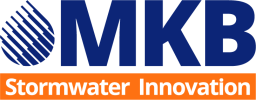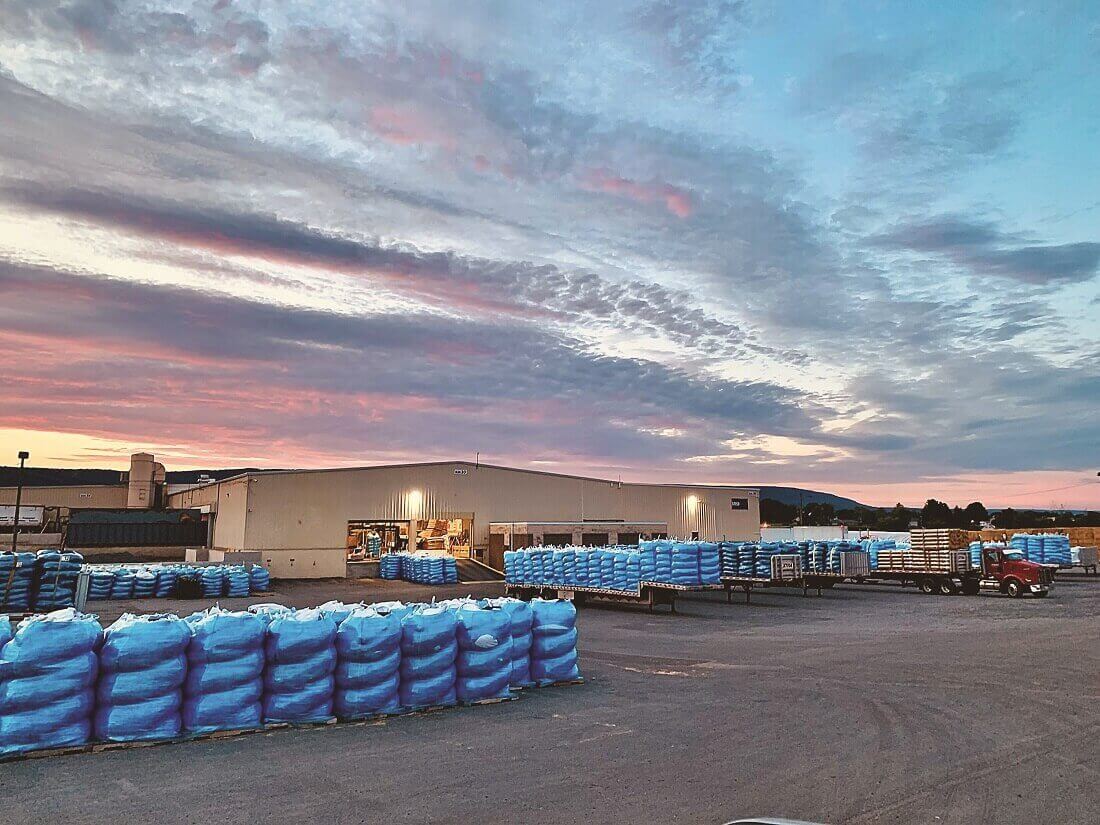In an era characterized by rapid urbanization and climate change, the effective management of stormwater and the removal of pollutants have become critical priorities for urban planners and environmentalists alike. As cities continue to expand, impenetrable surfaces replace natural landscapes, leading to increased stormwater runoff and the accumulation of pollutants in water bodies.
Below we will explore the importance of pollutant removal and stormwater management strategies in urban environments, their impact on the environment and public health, and innovative solutions to address these challenges.
Understanding Stormwater Management
Definition and Importance of Stormwater Management
Stormwater management refers to the process of controlling and using stormwater runoff, which is the water generated from precipitation events, such as rain or snowmelt. This runoff flows over the land surface, streets, lawns, and other sites, carrying with it various pollutants it picks up along the way. Effective stormwater management systems are designed to capture, store, and treat this runoff to reduce flooding, prevent erosion, and improve water quality.
The importance of stormwater management cannot be overstated. Uncontrolled stormwater can lead to significant environmental, economic, and social problems. Proper stormwater management helps mitigate the adverse impacts of runoff by reducing flood risks, protecting water resources, and maintaining healthy ecosystems. It also contributes to the resilience of urban areas against extreme weather events and climate change.
Impacts of Urbanization on Stormwater Runoff

Urbanization dramatically alters the natural landscape, replacing permeable surfaces like soil and vegetation with impervious surfaces such as asphalt and concrete.These surfaces prevent water from naturally infiltrating the ground, leading to higher volumes and faster flow rates of runoff. This can cause several problems, including:
- Increased Runoff Volume and Velocity: Impervious surfaces prevent water from naturally infiltrating into the ground, leading to greater volumes of surface runoff. This runoff moves more quickly over paved surfaces, increasing the risk of flooding and erosion in urban areas.
- Reduced Groundwater Recharge: In natural landscapes, much of the precipitation infiltrates into the ground, replenishing groundwater supplies. Urbanization disrupts this process, reducing groundwater recharge and lowering water tables, which can affect water availability for human use and natural ecosystems.
- Altered Hydrological Cycles: The disruption of natural infiltration processes changes the hydrological cycle, leading to increased surface water flows and decreased base flows in rivers and streams. This can result in more frequent and severe floods and reduced water availability during dry periods.
- Degraded Water Quality: Urban runoff often contains a variety of pollutants from roads, rooftops, and industrial sites. These include oils, heavy metals, nutrients, sediments, and pathogens, which can significantly degrade water quality in rivers, lakes, and coastal waters.
Challenges Posed by Stormwater Pollution
Stormwater pollution presents numerous challenges for urban areas, affecting both the environment and public health. Some of the primary challenges include:
- Pollutant Load Management: Stormwater can carry a wide range of pollutants, including nutrients (such as nitrogen and phosphorus from fertilizers), heavy metals (from vehicle emissions and industrial activities), pathogens (from pet waste and sewage overflows), and organic pollutants (such as pesticides and oils). Managing these diverse pollutants requires comprehensive strategies and technologies to treat runoff effectively.
- Infrastructure Costs: Building and maintaining stormwater management infrastructure, such as detention basins, green roofs, permeable pavements, and rain gardens, can be costly. Municipalities often face financial constraints that limit their ability to invest in necessary stormwater systems.
- Regulatory Compliance: Stormwater management is often regulated at the federal, state, and local levels. Compliance with these regulations can be complex and resource-intensive. Municipalities must navigate a maze of permits, standards, and reporting requirements to meet legal obligations.
- Public Awareness and Engagement: Effective stormwater management also depends on public awareness and engagement. Educating residents and businesses about the importance of reducing pollution at the source and adopting best practices (such as proper disposal of waste and minimizing the use of fertilizers) is crucial for the success of stormwater programs.
Implications of Stormwater Pollution on Water Quality, Aquatic Ecosystems, and Human Well-Being.
The implications of stormwater pollution are extensive and multifaceted, impacting water quality, aquatic ecosystems, and human well-being:
- Water Quality – Stormwater pollution is a major contributor to water quality degradation. Pollutants in stormwater can lead to elevated levels of nutrients, sediments, and toxic substances in water bodies. This not only makes water unsafe for drinking and recreational activities but also complicates water treatment processes, increasing costs for municipalities and water utilities.
- Aquatic Ecosystems – Healthy aquatic ecosystems are vital for biodiversity, providing habitat for fish, amphibians, invertebrates, and plants. Stormwater pollution can disrupt these ecosystems in several ways:
- Eutrophication: Excessive nutrients in runoff can cause algal blooms, which deplete oxygen levels in the water, leading to “dead zones” where aquatic life cannot survive.
- Habitat Destruction: Sedimentation from stormwater can smother habitats, such as spawning grounds for fish and breeding sites for amphibians, reducing biodiversity.
- Toxic Contamination: Heavy metals and organic pollutants can accumulate in the tissues of aquatic organisms, causing health issues and affecting food webs.
- Human Well-Being – The impact of stormwater pollution on human well-being is significant:
- Public Health: Contaminated stormwater can introduce pathogens and toxic substances into drinking water supplies, posing serious health risks. Recreational waters polluted by stormwater runoff can also cause illnesses in swimmers and other users.
- Flooding and Property Damage: Increased stormwater runoff can overwhelm drainage systems, leading to urban flooding. This can cause property damage, disrupt transportation, and necessitate costly emergency responses and repairs.
- Economic Costs: The economic burden of stormwater pollution includes increased healthcare costs, higher water treatment expenses, and losses related to property damage and reduced recreational opportunities.
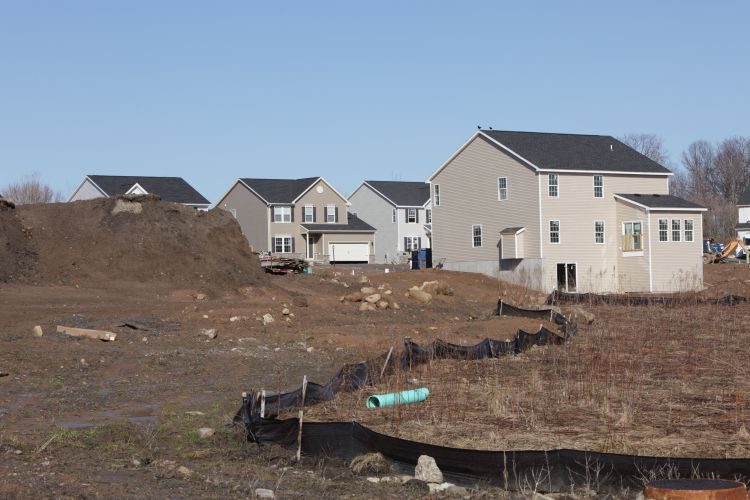
REGISTER FOR A VIRTUAL LUNCH & LEARN SESSION
Deepen your understanding of inlet protection and explore the latest trends and innovations in the field. During this session industry experts will share valuable insights, practical tips, and real-world case studies.
Earn 1 PDH Credit.
Pollutant Removal Techniques
Overview of Common Pollutants
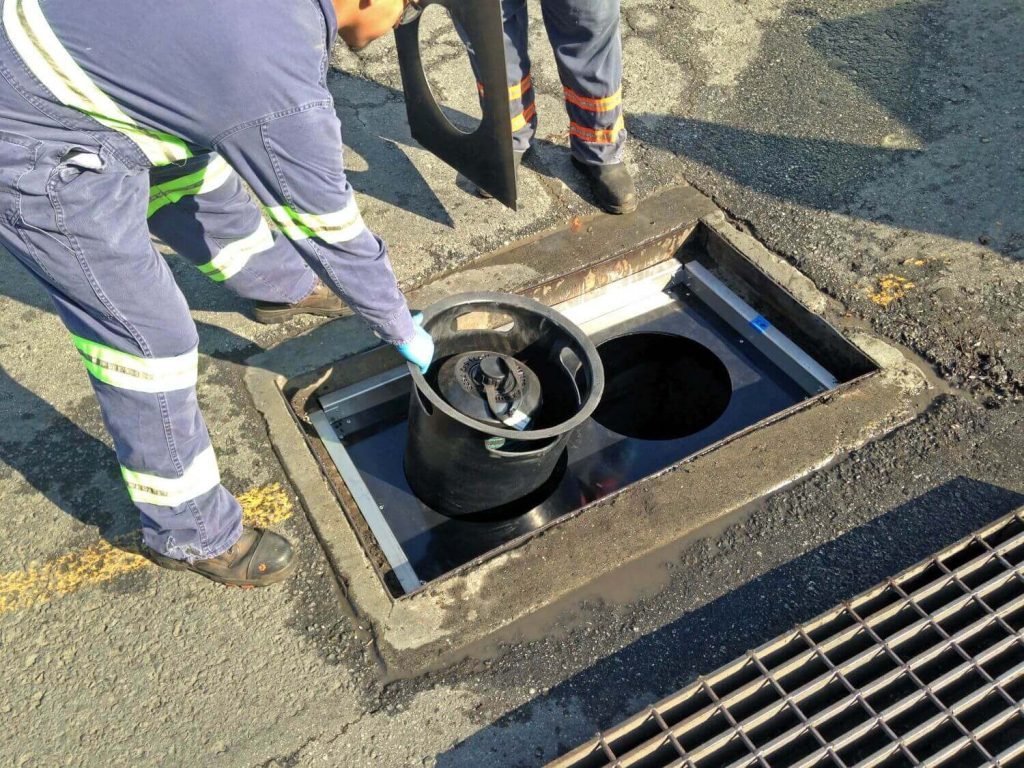
As previously mentioned, urban runoff is a significant environmental concern, especially in densely populated areas. As water flows over the urban landscape during and after precipitation events, it picks up various pollutants that can degrade water quality and harm ecosystems. Understanding the common pollutants in urban runoff is crucial for developing effective management and mitigation strategies. Here, we explore some of the most prevalent contaminants found in urban runoff, including sediment, heavy metals, nutrients, bacteria, and hydrocarbons.
- Sediment – Sediment consists of particles of soil, sand, and minerals that are washed into water bodies by stormwater. In urban areas, sediment primarily originates from construction sites, unpaved roads, and eroding landscapes. Excessive sediment in water bodies can cloud the water, reducing light penetration and affecting aquatic plants’ ability to photosynthesize. Sediment can also smother fish eggs and benthic organisms, disrupt habitats, and clog fish gills, leading to reduced populations of sensitive species. From an infrastructure standpoint, accumulated sediment can clog stormwater systems, reducing their efficiency and increasing maintenance costs.
- Heavy Metals – Heavy metals in urban runoff include lead, copper, zinc, cadmium, and mercury. These pollutants often come from vehicle emissions, industrial discharges, building materials, and atmospheric deposition. Heavy metals are toxic to aquatic life, even at low concentrations. They can cause behavioral changes, reproductive issues, and mortality in fish and invertebrates. Heavy metals can also accumulate in the tissues of aquatic organisms, entering the food chain and posing risks to predators, including humans. Heavy metals are also known to negatively impact water quality, and can render water unsafe for drinking, fishing, and recreational activities.
- Nutrients – Nutrients such as nitrogen and phosphorus are essential for plant growth but can become pollutants when present in excessive amounts. Major sources in urban areas include fertilizers, pet waste, septic systems, and atmospheric deposition. High nutrient levels can lead to the overgrowth of algae in water bodies, causing eutrophication. This process depletes oxygen levels in the water, resulting in dead zones where aquatic life cannot survive. Algal blooms caused by nutrient pollution can also produce toxins that are harmful to both aquatic life and humans, impacting drinking water sources and recreational waters. Furthermore, the loss of oxygen and changes in water chemistry can reduce biodiversity, favoring algal species over more sensitive aquatic plants and animals.
- Bacteria – Bacteria in urban runoff, particularly fecal coliforms like E. coli, primarily come from pet waste, sewage overflows, failing septic systems, and wildlife. Bacteria in water can make it unsafe for drinking, and can even cause gastrointestinal illnesses and infections in humans who come into contact with contaminated water through swimming or other recreational activities. In addition to making humans sick, high levels of bacteria can disrupt the natural balance of aquatic ecosystems, affecting the health and diversity of aquatic organisms.
- Hydrocarbons – Hydrocarbons are another common pollutant in urban runoff, originating mainly from vehicle emissions, motor oil, and industrial activities. These organic compounds, which include substances like benzene, toluene, and xylene, can be toxic to aquatic life even at low concentrations. Hydrocarbons tend to form oily films on the surface of water bodies, reducing oxygen transfer and impacting aquatic organisms’ respiration. Chronic exposure to hydrocarbons can lead to bioaccumulation in the tissues of fish and other aquatic organisms, posing long-term health risks and disrupting food chains. Hydrocarbons also contribute to the degradation of water quality, making it less suitable for drinking, recreational activities, and supporting diverse ecosystems.
Pollutant Removal and Stormwater Products
The presence of the pollutants described above pose significant challenges for water quality and ecosystem health. Effective stormwater management can include a combination of source control, mitigation products, and treatment systems, such as EnviroSoxx and StormExx.
EnviroSoxx : EnviroSoxx is a highly adaptable and cost-effective ‘above the grate’ filtration solution engineered to significantly reduce pollutants in stormwater. Crafted from exceptionally durable mesh, EnviroSoxx withstands hard surfaces and harsh conditions across various environments. Its seamless integration into existing stormwater management systems and readiness for immediate installation make it an ideal choice for any location. EnviroSoxx comes in two specialized filter blends:
- Industrial Blend: Targets heavy metals, hydrocarbons, nutrients, sediment, and pH levels.
- Advanced Blend: Focuses on removing bacteria, nutrients, hydrocarbons, select heavy metals, and sediment.
StormExx: StormExx catch basin filters are expertly designed to seamlessly fit most existing stormwater drain systems, effectively capturing sediment and pollutants, while remaining discreet from the street surface. It offers an ideal solution for areas where installing EnviroSoxx around inlets is challenging, inconvenient, or hazardous. Utilizing a replaceable cartridge with trash capture and advanced filtering media for under-the-grate stormwater treatment, StormExx provides a robust solution for maintaining water quality, while also simplifying installation, maintenance, and replacement.
Best Management Practices
Best Management Practices (BMPs) refer to methods, measures, or practices used to prevent or reduce the pollution of water bodies from stormwater runoff. They encompass a wide range of structural and non-structural solutions designed to manage the quantity and quality of runoff in both urban and rural settings. BMPs aim to reduce the velocity, volume, and pollutant load of stormwater before it reaches waterways. BMPs are generally categorized into two main types: structural and non-structural.
Non-Structural BMPs
Non-structural BMPs include policies, procedures, and practices aimed at preventing pollution at the source, including:
Public Education and Outreach – Informing the public about the impact of stormwater pollution and ways to reduce it, such as proper disposal of waste and minimizing the use of fertilizers.
- Good Housekeeping Practices – Ensuring that activities such as vehicle maintenance and landscaping are conducted in ways that minimize pollutant runoff.
- Erosion and Sediment Control – Implementing measures to prevent soil erosion and manage sediment at construction sites.
- Urban Planning and Zoning – Designing communities to include green spaces and reduce impervious surfaces.
- Regulatory Measures – Enforcing laws and regulations that control stormwater pollution, such as requiring permits for discharges and setting limits on pollutant levels.
Structural BMPs
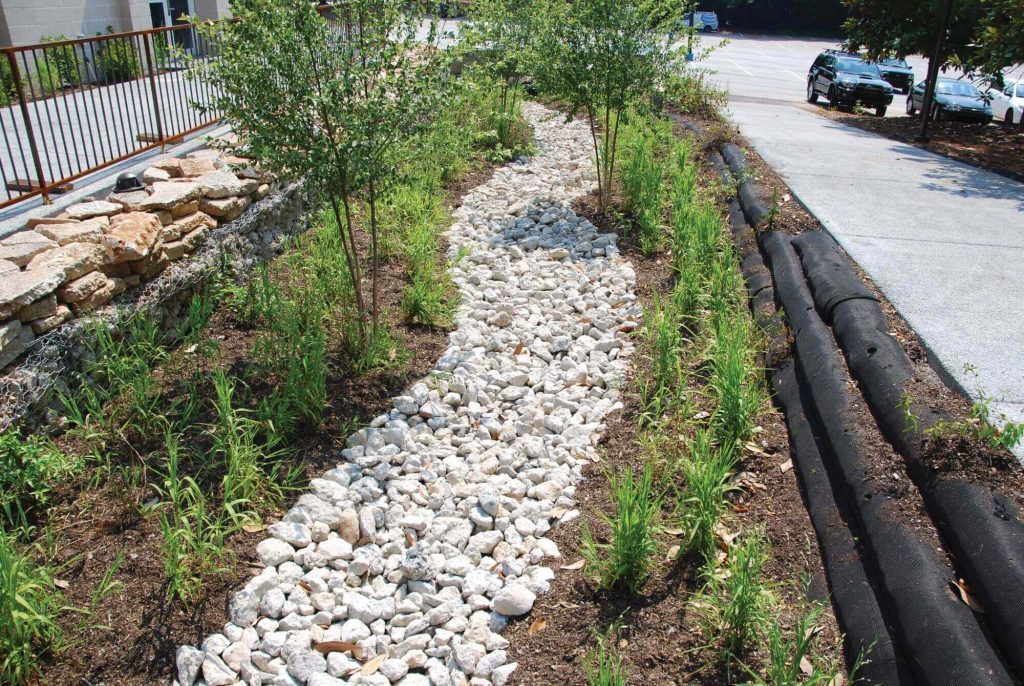
Structural BMPs involve the construction and implementation of facilities or devices designed to manage stormwater. MKB Company offers both above-ground and below-grate BMPs, often found in the below applications:
Channel Protection: Channel Protection involves measures to stabilize and protect channels from erosion caused by increased stormwater runoff. Channel protection can be used to establish, sustain, and reinforce vegetation in areas of concentrated flow and intense hydraulic pressure that typically undermine vegetation growth.
Bioswales: Bioswales are specially designed landscape features engineered to reduce silt, pollution, and other particles from stormwater runoff. These permanent, vegetated, shallow depressions or channels are designed to direct, slow, filter, and partially absorb stormwater. By facilitating infiltration of the initial surge of runoff and filtering subsequent flows, bioswales significantly improve water quality.
Check Dams: Check Dams are a simple and cost-effective BMP typically utilized in ditches, channels, and swales to safeguard specific areas by slowing the velocity of concentrated stormwater flows, thereby reducing bed erosion and filtering out sediment, pollutants, and other particles.
Inlet Protection: Inlet Protection involves installing barriers or filters around storm drain inlets to prevent sediment and debris from entering the stormwater system.
Perimeter Controls: Perimeter Controls serve as barriers to retain sediment on construction sites. Typically referred to as “perimeter controls,” these sediment control products are installed at the down-gradient boundaries of construction sites. They are placed down-slope of any disturbed areas to provide effective erosion control and filtration for runoff, ensuring sediment is contained within the site.
Slope Interruptions: Slope Interruptions minimize soil erosion by shortening slope lengths, thereby dissipating the energy of overland sheet flow runoff. By reducing runoff velocity, these practices decrease the likelihood of rill erosion on hill slopes. When pollution removal is required, EnviroSoxx can be incorporated within this BMP.
Green Infrastructure Solutions
Traditional stormwater management systems often rely on gray infrastructure, such as pipes and sewers, which can be costly and environmentally disruptive. Green infrastructure presents an innovative and sustainable alternative, integrating natural processes with engineered solutions to manage stormwater more effectively.
Green infrastructure refers to a network of natural and semi-natural systems that provide ecological benefits and enhance urban resilience. Unlike gray infrastructure, which primarily focuses on moving water away from urban areas, green infrastructure aims to manage stormwater at its source through absorption, infiltration, and evapotranspiration. This approach not only mitigates flooding but also improves water quality and enhances urban environments.
Key Benefits of Green Infrastructure
Improved Water Quality: Green infrastructure helps filter pollutants from stormwater before it enters water bodies. Vegetation and soil in green infrastructure systems act as natural filters, removing sediments, nutrients, heavy metals, and other contaminants. This leads to cleaner rivers, lakes, and aquifers, benefiting both ecosystems and human health.
Reduced Flooding: By absorbing and slowing down stormwater runoff, green infrastructure reduces the volume and peak flow of water entering drainage systems. This decreases the risk of urban flooding and alleviates the burden on traditional stormwater infrastructure.
Enhanced Urban Aesthetics and Biodiversity: Green infrastructure integrates natural elements into urban landscapes, enhancing the aesthetic appeal and providing habitats for wildlife. Parks, green roofs, and vegetated swales contribute to urban biodiversity and create pleasant spaces for recreation and community activities.
Climate Resilience: Green infrastructure enhances urban resilience to climate change by managing extreme weather events and mitigating urban heat islands. Vegetation cools the air through shade and evapotranspiration, reducing energy demands for cooling and improving overall urban comfort.
Green Infrastructure Applications and Products
Green Infrastructure Applications
In addition to the bioswales and channel protection BMPs described above, Green Infrastructure solutions can include:
Filtration Systems: Filtration Systems are designed to mimic natural processes by utilizing vegetation, soil, and other organic materials to capture, treat, and infiltrate stormwater runoff. Filtration systems provide a sustainable approach to managing stormwater by reducing the volume of runoff and removing pollutants before they reach natural water bodies.
Gabions: Gabions are wire mesh containers filled with rock, concrete, sand, or soil that can be strategically placed to slow down and retain stormwater runoff. When placed in the path of runoff, they create barriers that allow water to gradually infiltrate into the ground rather than flowing rapidly over impervious surfaces. This helps reduce erosion, sedimentation, and flooding downstream.
Walls, Slopes, and Shores: Living walls, slopes, and shores are innovative structures covered in vegetation that offer numerous environmental benefits, including permanent stabilization for extreme grade changes, along with stormwater management. Living walls are designed with a built-in irrigation system that supplies water to the plants. When it rains, the plants absorb water through their roots, reducing the amount of stormwater runoff that reaches the ground below. This process helps capture and retain stormwater, preventing it from overwhelming drainage systems and reducing the risk of flooding. Additionally, the soil and vegetation on living walls act as natural filters, trapping pollutants and sediments from stormwater runoff. These aesthetically pleasing solutions also provide habitat and food sources for birds, insects, and other wildlife, thus contributing to urban biodiversity.
Green Infrastructure Products
MKB Company offers two green infrastructure products that can be implemented within the above applications:
GreenLoxx: GreenLoxx systems offer a superior alternative to conventional block or concrete retaining walls, combining reinforcement capabilities with sustainable and aesthetic benefits. Available for slopes and walls, GreenLoxx utilize geotextile support to create a reinforced retaining wall that “locks” in place. This locking mechanism is achieved through the integration of geogrids and a fascia made from GroSoxx filled with GrowingMedia. The use of GroSoxx ensures exceptional soil retention and erosion protection, while also providing an optimal environment for vegetation growth.
GroSoxx: GroSoxx, a vegetated filter sock, can be used independently or synergistically within green infrastructure endeavors. Crafted from durable mesh netting and pre-filled with certified, composted GrowingMedia, GroSoxx can be used to stabilize soil, foster lush vegetation, and effectively manage stormwater runoff.
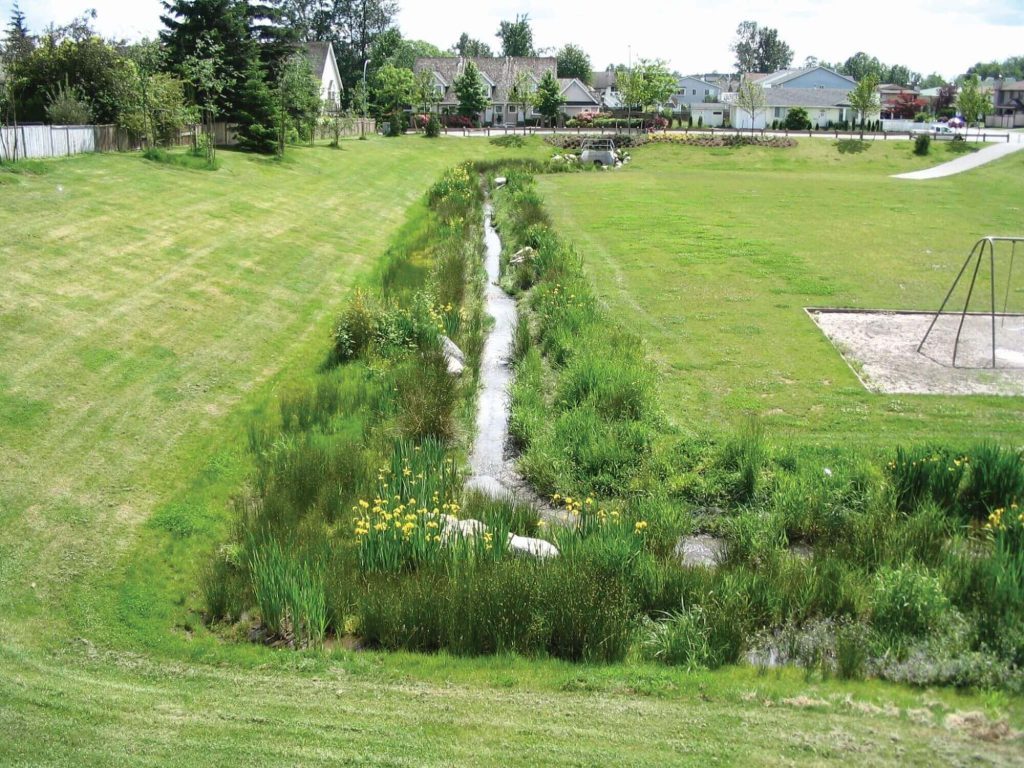
Technological Innovations
Emerging technologies in pollutant detection and monitoring, coupled with advances in stormwater treatment methodologies, are pivotal in paving the way for sustainable solutions. These innovations not only enhance our ability to identify and quantify pollutants but also revolutionize how we treat stormwater runoff, thereby safeguarding precious natural resources. Let’s delve into the forefront of these transformative technologies driving environmental stewardship.
Pollutant Detection and Monitoring Technologies
Remote Sensing and Satellite Imaging – Harnessing the power of satellite imagery and remote sensing technologies enables real-time monitoring of pollution sources, such as industrial discharges and urban runoff. By analyzing spectral signatures and spatial patterns, these tools provide invaluable insights into pollutant distribution and facilitate proactive intervention strategies.
Sensor Networks and IoT Integration – The proliferation of sensor networks and Internet of Things (IoT) devices offers granular, localized monitoring of pollutants in various environmental matrices. These sensors, ranging from chemical to biological indicators, provide continuous data streams, allowing for timely response to pollution events and informed decision-making.
Advanced Analytical Techniques – Innovations in analytical chemistry, including mass spectrometry, chromatography, and biosensors, enable rapid and precise identification of contaminants even at trace levels. Coupled with AI-powered algorithms, these techniques streamline data analysis and enhance predictive modeling for proactive pollution management.
Advances in Stormwater Treatment Technologies
Green Infrastructure Solutions – Green roofs, permeable pavements, rain gardens, and bioswales represent nature-based stormwater management solutions that mimic natural hydrological processes. These decentralized systems not only mitigate urban flooding but also promote infiltration, filtration, and biological uptake of pollutants, thus improving water quality downstream.
Advanced Filtration and Adsorption Systems – Next-generation filtration media exhibit enhanced adsorption capacities for a wide range of pollutants, including heavy metals, nutrients, and organic contaminants. These engineered filtration systems complement traditional sedimentation and filtration practices, offering superior pollutant removal efficiency.
Electrochemical Treatment Technologies – Electrocoagulation, electrooxidation, and electrochemical advanced oxidation processes (EAOPs) harness electrochemical principles to degrade pollutants and disinfect stormwater effluents. These electrochemical technologies are highly effective in removing emerging contaminants, pathogens, and microplastics, presenting a promising avenue for sustainable stormwater treatment.
Case Studies and Success Stories
MKB Company’s Stormwater Management and Pollutant Removal products have proven to be instrumental as BMPs in the field. Industry research has revealed that StormExx has the ability to target and remove TSS, nutrients, and heavy metals, while EnviroSoxx has demonstrated excellence in maintaining performance while effectively removing a wide range of stormwater pollutants across multiple exposure events. The implementation of multiple EnviroSoxx within a stormwater treatment system has also been shown to significantly increase pollutant removal performance and further decrease concentrations of stormwater pollutants. For access to these and additional research summaries, please explore our Document Library.

REGISTER FOR A VIRTUAL LUNCH & LEARN SESSION
Deepen your understanding of inlet protection and explore the latest trends and innovations in the field. During this session industry experts will share valuable insights, practical tips, and real-world case studies.
Earn 1 PDH Credit.
Lessons Learned From Successful Pollutant Removal and Stormwater Management Projects.
In the ongoing quest for environmental sustainability, successful pollutant removal and stormwater management projects stand as beacons of innovation and effectiveness. These projects not only demonstrate tangible improvements in water quality but also offer invaluable insights and lessons for future endeavors. Key takeaways include:
Integrated Approach is Key – Successful projects often adopt an integrated approach that combines various stormwater management techniques and pollutant removal strategies. By synergizing green infrastructure solutions, advanced filtration systems, and community engagement initiatives, these projects achieve holistic and sustainable outcomes that address multiple environmental challenges simultaneously.
Tailored Solutions for Local Conditions – One size does not fit all when it comes to stormwater management. Projects that thrive in pollutant removal typically tailor their solutions to suit the specific hydrological, geographical, and socio-economic conditions of the local environment. Understanding the unique challenges and opportunities presented by each watershed or urban area allows for the development of customized strategies that maximize effectiveness and resilience.
Monitoring and Adaptive Management – Continuous monitoring and adaptive management are critical components of successful pollutant removal and stormwater management projects. By collecting comprehensive data on water quality parameters, flow dynamics, and pollutant loads, project teams can assess performance, identify trends, and make informed adjustments to optimize efficacy over time. This iterative process ensures that interventions remain effective in the face of evolving environmental conditions and regulatory requirements.
Public Engagement and Education – Community involvement and public education play pivotal roles in the success of pollutant removal and stormwater management initiatives. Projects that prioritize stakeholder engagement, outreach programs, and educational campaigns foster a sense of ownership and responsibility among residents, businesses, and local organizations. By raising awareness about the importance of water quality protection and the role of individual actions, these projects cultivate a culture of environmental stewardship that extends beyond project boundaries.
Collaboration and Partnerships – Successful projects leverage the power of collaboration and partnerships to pool resources, expertise, and funding from diverse stakeholders. By forging alliances between government agencies, non-profit organizations, academia, industry, and community groups, these projects harness collective knowledge and capacities to tackle complex environmental challenges more effectively. Synergistic partnerships facilitate knowledge sharing, innovation diffusion, and mutual support, ultimately amplifying the impact of pollutant removal and stormwater management efforts.
Future Direction
As urbanization accelerates and climate change intensifies, the intersection of these two trends presents formidable challenges for stormwater management. Urban areas are particularly vulnerable to the impacts of climate change, including more frequent and intense rainfall events, rising temperatures, and sea-level rise. Anticipating these trends is crucial for developing resilient stormwater management strategies that can mitigate flooding, reduce pollution, and safeguard water resources. Possible trends in urbanization and climate change and their profound impact on stormwater management include:
Rapid Urbanization: The global trend of urbanization is expected to continue unabated, with more people flocking to cities in search of economic opportunities and better standards of living. As urban populations swell, so does the demand for infrastructure, housing, and services. The expansion of impervious surfaces, such as roads, parking lots, and rooftops, exacerbates stormwater runoff, leading to increased flooding, erosion, and pollution of waterways.
Intensifying Climate Change Impacts: Climate change amplifies the severity and frequency of extreme weather events, including heavy rainfall, heatwaves, and storms. Urban areas are particularly susceptible to these impacts due to their dense populations, impermeable surfaces, and inadequate drainage systems. Flooding, urban heat islands, and water quality degradation are among the pressing challenges exacerbated by climate change, further straining stormwater management infrastructure and resources.
Green Infrastructure Adoption: In response to the dual challenges of urbanization and climate change, there is a growing recognition of the importance of green infrastructure in stormwater management. Green roofs, permeable pavements, rain gardens, bioswales, and constructed wetlands offer nature-based solutions that mimic natural hydrological processes, allowing for infiltration, filtration, and retention of stormwater onsite. These green infrastructure practices not only reduce runoff volume and peak flow but also enhance water quality and biodiversity in urban environments.
Smart Stormwater Management Technologies: Advances in technology, including sensor networks, real-time monitoring systems, and predictive modeling tools, enable smarter and more efficient stormwater management. By leveraging data-driven insights and predictive analytics, municipalities and water utilities can optimize the operation of stormwater infrastructure, prioritize maintenance activities, and mitigate flood risks in real-time. Smart stormwater management technologies empower decision-makers to anticipate and respond proactively to changing environmental conditions.
Policy and Regulatory Frameworks: Policy and regulatory frameworks play a critical role in shaping stormwater management practices and outcomes. Governments at the local, regional, and national levels are increasingly adopting stringent regulations and standards to address stormwater runoff, water quality, and flood risk management. These policies incentivize the implementation of green infrastructure, promote sustainable land use planning, and encourage community resilience measures in the face of climate change.
Conclusion
In conclusion, the effective management of stormwater and removal of pollutants are essential in safeguarding our urban environments, public health, and ecosystems. As urbanization and climate change continue to pose significant challenges, adopting integrated stormwater management strategies that incorporate green infrastructure, advanced technologies, and community engagement is crucial. Products like EnviroSoxx and StormExx demonstrate the potential of innovative solutions to enhance pollutant removal efficiency and improve water quality. By learning from successful case studies and leveraging emerging technologies, we can develop resilient and sustainable stormwater management systems. Moving forward, it is imperative to tailor these strategies to local conditions, monitor their performance continuously, and engage the public to foster a culture of environmental stewardship. Through collaboration and proactive policy frameworks, we can create urban landscapes that are not only resilient to climate change but also conducive to healthier ecosystems and communities.
